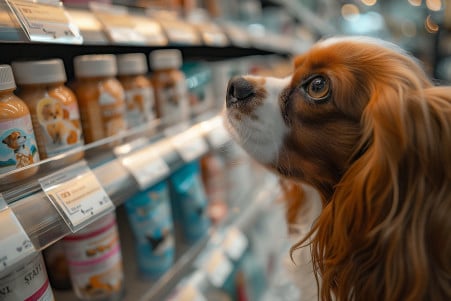My Dog Ate Gum: How to Tell If Your Dog Has Xylitol Poisoning
15 March 2024 • Updated 13 March 2024

If your dog has recently eaten gum, you may be dealing with a medical emergency. The first step is to figure out if the gum your dog ate contains xylitol. If it does, your dog may experience hypoglycemia and liver failure, which can cause symptoms like vomiting and weakness. You should take your dog to the vet immediately, as the sooner they receive treatment, the better their chances of recovery.
This article will cover a number of veterinary case reports, toxicological investigations, and animal health research to help you better understand the risks and appropriate responses to a dog eating gum. This research provides valuable information on the signs, treatments, and ways to prevent xylitol poisoning and other dietary issues in dogs. By the end of this article, you’ll be well-informed on how to keep your dog safe from similar dangers.
How can you tell if your dog has xylitol poisoning?
How to Tell If Your Dog Has Xylitol Poisoning
In the case of xylitol poisoning in dogs, time is of the essence. Dogs can have a rapid and severe initial reaction to the substance, which includes vomiting, incoordination, and weakness, according to the American Kennel Club. If you see these symptoms, you need to act quickly because it can progress to more severe symptoms, such as seizures and liver failure, in no time.
Veterinarians in Murfreesboro say that symptoms can start to show in as little as 30–60 minutes, so it’s important for dog owners to keep a close eye on their pets and be ready to act. Dog owners should also keep track of the symptoms their pets are experiencing and when they started because this information will be important for the vet.
While you’re getting ready to take your dog to the vet, make sure that they are in a safe and secure area where they won’t hurt themselves or be hurt by others. Don’t give them food or try to make them throw up unless a vet tells you to because it could make things worse.
And remember, the faster you can get your dog to the vet, the better their chances of recovery.
How to Help a Dog With Xylitol Poisoning
If your dog is being treated for xylitol poisoning, time is of the essence. According to Pet Check Urgent Care, your vet will likely start by inducing vomiting to remove the gum, especially if the xylitol was ingested in the last 30 minutes.
After that, your vet will likely give your dog IV fluids to help with dehydration and prevent hypoglycemia. To prevent liver damage, medications that protect the liver will be given, as well as sugar to help maintain normal blood sugar levels.
Both the vets in Murfreesboro and the American Kennel Club note that it’s important to monitor blood sugar and liver enzymes. Blood work will need to be done regularly to check on the dog’s progress and see if further treatment is needed. In some cases, the dog may need to be hospitalized to ensure that they are being monitored and treated around the clock and to address any complications that may arise.
The prognosis for dogs with xylitol poisoning can vary, but the sooner treatment is started before symptoms appear, the better the chances of a positive outcome. That said, if the dog goes into liver failure or a coma, the situation can become dire.
The fact that you will need to keep a close eye on your dog’s health after an incident like this shows how serious the effects of xylitol can be and how important it is to take steps to prevent it.
How Xylitol Affects Dogs
When dogs consume xylitol, their bodies mistakenly identify it as real sugar and release a rapid and potent surge of insulin. According to the Merck Veterinary Manual, this response is much more extreme in dogs than in humans and can result in a rapid and severe drop in blood sugar, which is called hypoglycemia.
While xylitol does not cause an insulin release in humans, it can cause hypoglycemia in dogs within 30 minutes to an hour, according to a study in Topics in Companion Animal Medicine.
The metabolic pathways in dogs are responsible for the toxicity of xylitol. According to a case study published by PMC, xylitol is quickly absorbed into a dog’s bloodstream, which causes a sudden increase in insulin and hypoglycemia.
The same study also published a case report that found liver failure and coagulopathy can occur with a high enough dose of xylitol. This is supported by a study in Veterinary Medicine, which found that doses of xylitol greater than 0.5 g/kg are associated with hepatic necrosis, which is often fatal.
Case studies, like the one published by PMC, also provide important information about treatment. In this case, a dog that developed acute liver failure after consuming a large amount of xylitol was successfully treated with interventions like intravenous dextrose and liver protectants.
These examples show why ongoing veterinary research is so important. It helps us learn more about xylitol poisoning in dogs and how to treat it, which can help improve the chances of a successful outcome.
Protecting Your Pup: How to Prevent Xylitol Poisoning
The first step in preventing xylitol poisoning in your dog is to dog-proof your home. This means keeping gum and other products that contain xylitol in a place that is either too high or behind a door that your dog can’t open.
The FDA stresses the importance of being able to act quickly in the event that a dog does get into something that contains xylitol, so keeping these items out of reach is an important part of prevention.
It’s also important to make sure that everyone in the household is aware of the danger. The American Animal Hospital Association recommends making sure that everyone in the household, especially children, knows that xylitol is toxic to dogs. This is important to make sure that everyone is careful not to leave gum or other products that contain xylitol where dogs can get to them.
Dispose of gum by wrapping it up and putting it in a trash can with a lid. You can also use the ASPCA’s recommendations for dog-friendly treats. Make sure to always read labels to check for xylitol, which may be listed under other names like birch sugar or wood sugar.
Preventing accidental ingestion is also important because it’s not just xylitol that can be toxic to pets.
By being aware and taking steps to prevent accidental ingestion, you can help keep your pet safe.
Other Risks of Canine Pica
The risks associated with pica in dogs, or the consumption of non-food items, are similar to those of xylitol poisoning. According to MedVet, dogs that eat non-digestible items can develop gastrointestinal obstructions, which can lead to symptoms like vomiting and lethargy, which are similar to the early signs of xylitol poisoning.
Unlike xylitol toxicity, which requires immediate medical attention to treat hypoglycemia and liver failure, gastrointestinal obstructions require a physical procedure to remove the foreign body, such as endoscopy or surgery.
According to PetMD, pica in dogs can be caused by a number of factors, including nutritional deficiencies, boredom, and underlying medical issues, and can lead to complications like gastrointestinal obstructions and toxicity. These issues are typically diagnosed by a vet using radiographs or ultrasounds, which are also used to detect xylitol in the body.
In both cases, quick medical attention and careful management of the dog’s environment are necessary for successful treatment and recovery. The FDA encourages pet owners to act fast if their pets consume something toxic, and to be aware of the many hazards that exist in their homes. Knowing a dog’s habits and needs can help prevent these issues and keep them safe and healthy.
Summary: How to Prevent Xylitol Poisoning in Dogs
As discussed in this article, the risks of xylitol in gum for dogs are real and the potential consequences are dire. It is important for pet owners to be able to quickly identify and respond to the symptoms, which can include vomiting and liver failure. It is also important for pet owners to watch their dogs closely and be ready to seek emergency veterinary help at the first sign of a problem.
Prevention is just as important. You can greatly reduce the risk of poisoning by keeping xylitol-containing products like gum away from your dog, making sure everyone in your household knows about the risks, and properly disposing of gum. The FDA and ASPCA also recommend reading labels and avoiding products that contain xylitol to protect your pets.
In short, the health of our four-legged friends depends on the knowledge and awareness of their human caretakers. By knowing the risks, recognizing the symptoms, and taking steps to prevent poisoning, you can help protect your dog. And always remember, the information you learn today could make the difference between a near miss and a devastating loss tomorrow.


